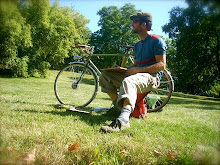
Several years back, while teaching along the adjunct circuit at my local art schools, I found myself preaching a steady diet of spatial issues and their relationship to the strictly formal, two-dimensional dynamics.
Richard Diebenkorn was my staple example of a painter keenly aware of the pliable perception of the picture plane and its ability to be transformed in the viewers eye into something more tangible, when given enough cues. And that a whole array of vocabulary can be employed to suggest a specific place or region.
Milwaukee is a city that was built on a large marshland. The rivers that form a confluence carve small paths in the surrounding areas and the land rises slowly and subltly from the water's edges. Being at the end of the Iron Belt in the upper midwest, Milwaukee has a rich history as a manufacturing center. Therefore, in large measure there are scores of low lying buildings that rise ever so slightly, in relationship to the earth and to each other. Milwaukee is a city that was cobbled together by many European craftsmen and being rather religious every group & every neighborhood has it's churches, mostly Catholic, and Lutheran and some Protestant. Church Spires pierce the sky near and far. Utilitarian structures are seen in contrast or in concert with the architecture of the divine. intertwined with nature, both cultivated and indigineous. Milwaukee has a wonderful park system that was devised in the early days of the city's growth. The immigrant's, German & others, thought of these vital greenspaces as the lungs of the city...and shame on County Exec. Scott Walker for neglecting this public heritage! ...I digress,...what I describe above are the elements that began to inform my work in the early part of the decade, when I called myself an instructor. Though I have drifted away from a life in academia, on other currents of life, I carry many of those experiences with me.

.....So, while teaching painting in a summer pre-college program, One of the many places & spaces I came to know intimately, was in our "backyard". I began to exploit this spot, as it offered many long vistas to gaze down. This is an area in the city, not far from the big lake and is in the basin of the city on the SE side. There is a great deal of industrial activity and a train line runs through. The detritus of years of commerce, shipping, storing and whatever activities, is apparent, though there is a rich growth of foliage as well. During one summer session, I decided that if the weather held I would have the students work on a panoramic composition. Given Milwaukee's history as one of the panorama house centers, it seemed appropriate to attempt. As you see above in my painting,
Polyrhythm 1: Milwaukee Basin, students worked in a similar fashion to develop a series of small drawings on paper, from this site. I asked them to attempt to get as close to 360 degrees as possible. Most students seemed to fall somewhere between 90 and 180 degrees. After, a few days of drawing and little time to paint, the workshop came to a close and we hung the results in our final exhibition. Sadly, I did not adaquetly document these paintings. I was struck by their sense of rhythm, and and movement. They were layered and lyrical, and no matter the level of skill they all had a pulse! Following this experience I knew I had to try this project for myself.....

...I started my project in the waning days of summer, in late august of 2002. I too had intentions of recording 360 degrees of space, but only managed aproximately 100 degrees. I spent many afternoons drawing in graphite on the panels I had prepared earlier in the summer. At first I would go out with light drawing supplies and a panel or two. From where I parked..(this was prior to my bicycle drawing journeys)... the trek down the train tracks was several hundred yards to the point of view I had chosen. This was still a manageable walk. Once the paintings began in earnest I quickly realized a need to find a way to hike in with my supplies and all the panels. I of course needed them to be stable as I would leave with wet panels. I was painting these with an oil & beeswax medium, so they were slightly set-up as I would leave, but It was during the hot August sun and into the early color change of september.

...This, then, is the case I built to house the work as it was being transported.

...Most of this view has been built over by some light industrial expansion. I did not complete this painting until 2004, which followed the early days of the new construction. These images were shot in my studio this past week as I was getting work ready to drop off at
Katie Gingrass Gallery

















